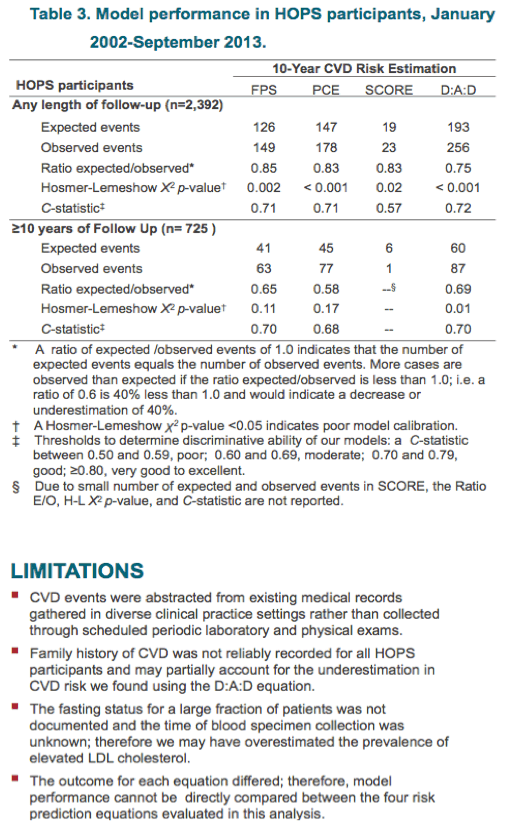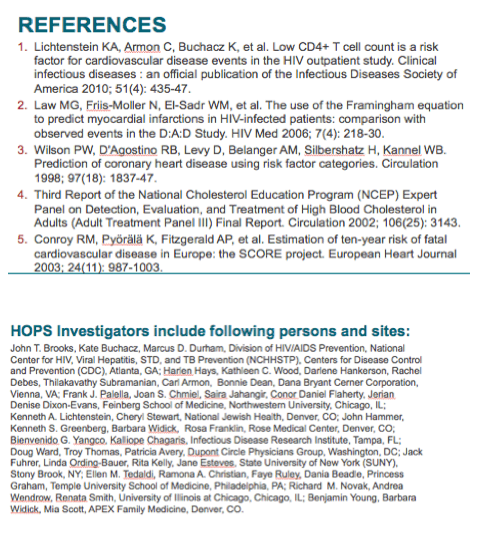 |
 |
 |
| |
Cardiovascular Disease Risk Prediction in the HIV Outpatient Study (HOPS)..... "Among participants with any length of follow-up, the four risk prediction equations underestimated the 10-year risk of CVD"
|
| |
| |
from Jules: 56% white, 29% Black; 35% current smokers; 8.3-9.7% diabetes; hypertension 49-55%; incident cardiovascular events: 8.5% in all participants, 12.6% in those followed for 10 yrs or more, see Table 2.
Reported by Jules Levin
CROI 2015 Feb 23-26, Seattle, WA
Angela Thompson-Paul1,2, Kenneth A. Lichtenstein3, Carl Armon4, Kate Buchacz1, Rachel Hart4, Joan S. Chmiel5, Frank J. Palella5, Stanley C. Wei1, Jacek Skarbinski1, John T. Brooks1
1Division of HIV/AIDS Prevention, Centers for Disease Control and Prevention, Atlanta, GA; 2Epidemic Intelligence Service, Centers for Disease Control and Prevention, Atlanta, GA; 3National Jewish Health, Denver, CO; 4Cerner Corporation, Vienna, VA;
5Feinberg School of Medicine, Northwestern University, Chicago, IL; 5University of Illinois, Chicago, IL;

-------------------------
Program Abstract-
Cardiovascular Disease Risk Prediction in the HIV Outpatient Study (HOPS)
Primary Author:
Angela Thompson-Paul1, Kate Buchacz1, Stanley Wei1, Jacek Skarbinski1, John Brooks1, Kenneth Lichtenstein2, Carl Armon3, Rachel Debes3, Joan Chmiel4, Frank Palella4
1 US Centers for Disease Control and Prevention, Atlanta, Georgia, United States;2 National Jewish Health, Denver, Colorado, United States;3 Cerner Corporation, Vienna, Virginia, United States;4 Northwestern University, Feinberg School of Medicine, Chicago, Illinois, United States
Abstract Body:
Background: HIV infection is associated with an increased risk of cardiovascular disease (CVD); however, it is unknown if commonly used CVD risk prediction tools accurately predict risk in HIV-infected persons. In this analysis, we examined four CVD risk prediction equations to determine if they accurately estimate events and predict risk events in a large diverse cohort of HIV-infected adults in the United States.
Methods: We analyzed longitudinal data on HIV Outpatient Study (HOPS) participants in care at 10 U.S. clinic sites as of 30 September 2013 who met the following criteria: had at least one year of follow-up after 1 January 2002, enrolled in the HOPS no later than 1 October 2010, had at least one total cholesterol measurement, and at least two systolic blood pressure measurements at baseline. We applied four CVD risk equations to the HOPS data to estimate 10-year CVD risk, and using Harrell's C-statistic assessed their predictive ability to discriminate patients who did vs. did not experience incident CVD events. Incident CVD events were defined for each risk equation are as follows: 1) Framingham Point Score (FPS)- myocardial infarction (MI), fatal coronary heart disease (CHD), stroke; 2) Pooled Cohort Equation (PCE) - MI, stroke, coronary artery disease (CAD); 3) Systematic COronary Risk Evaluation (SCORE) for low-risk populations - fatal MI, stroke, peripheral vascular disease, CAD; and 4) the Data Collection on Adverse Effects of Anti-HIV Drugs (D:A:D) study equations - MI, sudden death, CAD, stroke, and death from other CHD.
Results: There were 2392 participants with a median age of 43 years; 76% were male, 50% were non-Hispanic white, and 87% were antiretroviral experienced at baseline. Common co-morbid conditions included hypertension (50%), diabetes (10%), and high cholesterol (17%). In this cohort, 204 incident CVD events occurred during a median follow-up time of 6.5 years. All equations underestimated 10-year CVD risk to a variable degree (Table 1). The FPS, PCE, and D:A:D equations showed moderate discrimination (C-statistic range, 0.68 to 0.72), whereas SCORE showed poor discrimination (C-statistic=0.59).
Conclusions: The four risk prediction equations underestimated the 10-year risk of CVD in our large, diverse cohort of HIV-infected adults. To better estimate CVD risk in HIV-infected persons in the U.S., additional risk factors, such as immunologic or virologic status may need to be considered.
--------------------








|
| |
|
 |
 |
|
|